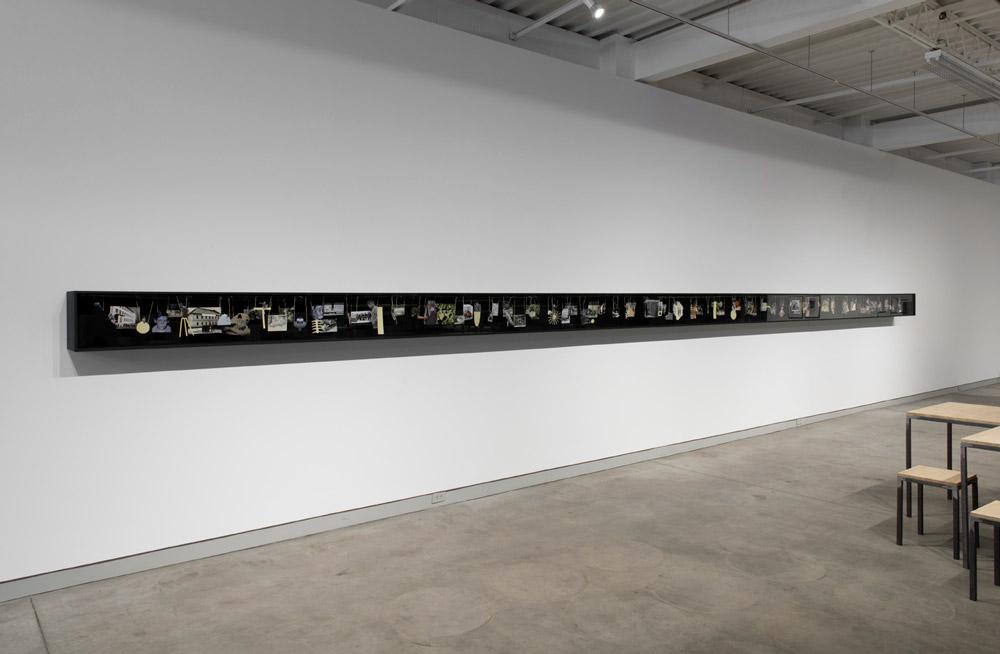“Every educational system is a political means of maintaining or of modifying the appropriation of discourse, with the knowledge and the powers it carries with it.”—Michel Foucault, The Archaeology of Knowledge and the Discourse on Language
With a minimalist approach and restrained palette, Czech artist Eva Kotátková’s solo exhibition at Scrap Metal, her first in Canada and presented by Art en Valise, incorporates collage, sculpture, installation, works on paper and performance to produce a cautionary look at the body and the institutional structures that govern it—namely, schools, libraries and clinics. Last year, Kotátková presented her Asylum (2013) in “The Encyclopedic Palace” at the 55th Venice Biennale, a work that explored the “phantasmagoric visions, dreams and utopias of psychiatric patients,” and her show at Scrap Metal picks up on related themes.
By employing the language of Surrealist aesthetics, Kotátková illustrates the sinister possibilities of institutional systems while exposing the absurdity of their underpinnings. Here, banal objects of the everyday—textbooks, desks and wheelchairs—are manipulated and transformed to encapsulate ideologies of control, betterment and normativity that are espoused by the educational system writ large. As a whole, her works come together to form an archive of fears and anxieties.
Kotátková moves deftly between scale and medium, drawing viewers close to intricate, intimate collages and line drawings while encouraging them to consider their own corporeal discomfort in relation to life-sized machines for the body. Her machines restrict and control movement, and include a modified wheelchair that positions the head and legs by way of menacing metal cages. Also present is a wearable steel-frame library, House Arrest no. 4 construction for reading (2010), that is worn on the front of the body but positions most books at such a distance that they are impossible for the wearer to read.
Throughout the exhibition, the artist has culled and reorganized materials that speak to the project of normative standardization. These materials include clippings from what are likely psychology and sociology texts illustrating tests, diagrams and experiments, as well as excerpts from exercise books for handwriting and from flashcards. Many of these illustrations are numbered or lettered, further alluding to the highly regimented classificatory systems employed by libraries, museums and schools.
One such illustration features 21 crude drawings of a single human figure. Rendered by schoolchildren of the same age, the line drawings are organized from most rudimentary to most elaborate, with emphasis placed on the central image, which is meant to illustrate average developmental ability. An interesting parallel might be drawn between this emphasis on normative standards in education and the egalitarian goals of the Communist project into which Kotátková was born.
Yet Western ideologies don’t escape the rigours of Kotátková’s oeuvre either. In a recent conversation at the gallery, the artist relayed her memories of Prague’s political changeover from from communism to democracy—a transition she experienced as a first-grade student in the city. Despite the rhetoric of freedom and change touted by the new regime, Kotátková’s experience of the pedagogical and educational strategies employed by the new government remained narrow-minded and restrictive, echoing those of their predecessor.
By appropriating images and ephemera of primary education and schoolchildren, and modifying them through simple white line drawings of cages, webs, masks and harnesses, as well as through angular metal supports, Kotátková taps into a near-universal experiential base that nestles itself between familiarity and unease. What we see is not the idyllic view of childhood, but rather the shadowed side of a youthful experience replete with anxieties, nightmares, fears and phobias—specifically those that emerge by way of containment, repression and restriction. It is a menacing vision, but one that is articulated with a beauty which makes the violence of Kotátková’s objects easier to swallow.









